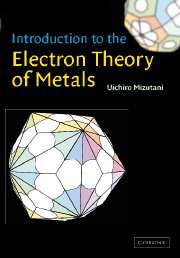Book contents
- Frontmatter
- Contents
- Preface
- 1 Introduction
- 2 Bonding styles and the free-electron model
- 3 Electrons in a metal at finite temperatures
- 4 Periodic lattice, and lattice vibrations in crystals
- 5 Conduction electrons in a periodic potential
- 6 Electronic structure of representative elements
- 7 Experimental techniques and principles of electronic structure-related phenomena
- 8 Electronic structure calculations
- 9 Electronic structure of alloys
- 10 Electron transport properties in periodic systems (I)
- 11 Electron transport properties in periodic systems (II)
- 12 Superconductivity
- 13 Magnetism, electronic structure and electron transport properties in magnetic metals
- 14 Electronic structure of strongly correlated electron systems
- 15 Electronic structure and electron transport properties of liquid metals, amorphous metals and quasicrystals
- Appendix 1 Values of selected physical constants
- Principal symbols (by chapter)
- Hints and answers
- References
- Materials index
- Subject index
12 - Superconductivity
Published online by Cambridge University Press: 20 November 2009
- Frontmatter
- Contents
- Preface
- 1 Introduction
- 2 Bonding styles and the free-electron model
- 3 Electrons in a metal at finite temperatures
- 4 Periodic lattice, and lattice vibrations in crystals
- 5 Conduction electrons in a periodic potential
- 6 Electronic structure of representative elements
- 7 Experimental techniques and principles of electronic structure-related phenomena
- 8 Electronic structure calculations
- 9 Electronic structure of alloys
- 10 Electron transport properties in periodic systems (I)
- 11 Electron transport properties in periodic systems (II)
- 12 Superconductivity
- 13 Magnetism, electronic structure and electron transport properties in magnetic metals
- 14 Electronic structure of strongly correlated electron systems
- 15 Electronic structure and electron transport properties of liquid metals, amorphous metals and quasicrystals
- Appendix 1 Values of selected physical constants
- Principal symbols (by chapter)
- Hints and answers
- References
- Materials index
- Subject index
Summary
Prologue
We learned in Chapter 10 that lattice vibrations in a metal always give rise to a finite resistivity and that it disappears only when the metal resumes perfectly periodic ion potentials at absolute zero. However, there are many metals the resistivity of which completely vanishes at finite temperatures. Kamerlingh Onnes from the Netherlands, is famous for his success in liquefying helium for the first time in 1908. During his extensive studies on the electrical resistivity of various metals by immersing them in liquid helium, he happened to discover in 1911 that the resistivity of mercury suddenly drops to zero at 4.2K, the boiling point of liquid helium at 1 atmospheric pressure. This is the superconducting phenomenon discovered three years after his helium liquefaction.
Since then, superconductivity has been discovered in many metals, alloys and compounds. As listed in Table 12.1, the value of the superconducting transition temperature Tc of elements in the periodic table is always less than 10K. Many researchers have attempted to synthesize new superconductors with as high a Tc value as possible. In 1986, Bednorz and Müler revealed that the electrical resistivity of La–Ba–Cu–O sharply dropped at about 35K and vanished below about 13K and pointed out the possibility of synthesizing a new high-Tc superconducting oxide. Their work opened up a new era for the research of high-Tc superconductors and the Nobel Prize in physics was awarded to them in 1987 for their discovery.
- Type
- Chapter
- Information
- Introduction to the Electron Theory of Metals , pp. 334 - 382Publisher: Cambridge University PressPrint publication year: 2001

